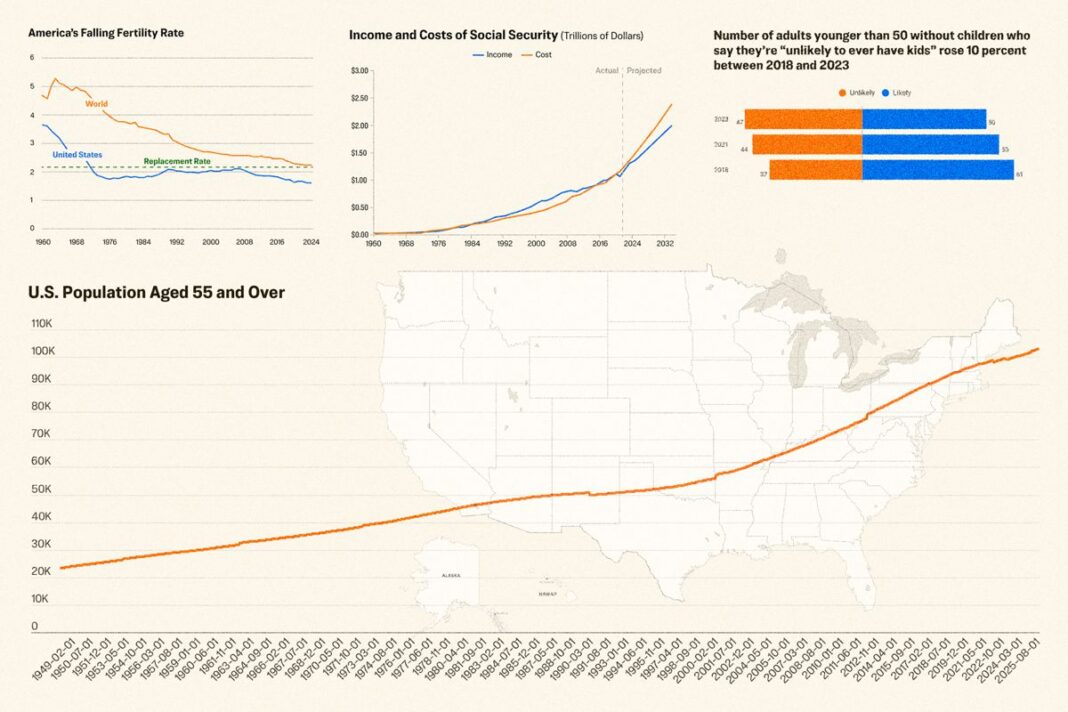The median age of adults topped 39 years in 2024, while fertility and birth rates are in decline. Experts said major changes are ahead.
The data are in: The United States is getting older and welcoming fewer babies. This decades-long phenomenon is creating a demographic squeeze that some anticipate will affect nearly every aspect of the nation’s economy and infrastructure over the next couple of decades.
“I see a total reshuffling of our economy and society, brought about by historic demographic turnover,” regenerative medicine specialist Dr. David Ghozland told The Epoch Times.
In a report for the American Enterprise Institute, economist Jesús Fernández-Villaverde called falling U.S. fertility rates “the true economic challenge of [the] time.”
The number of adults aged 65 and older is forecast to hit 82 million by 2050 and will make up 23 percent of the population, according to the Population Reference Bureau. That is a 42 percent increase from 58 million people aged 65 and older in 2022.
Meanwhile, the general fertility rate—the number of live births per 1,000 women of childbearing age—has dropped to record lows. The North American rate plummeted from 3.1 in 1950 to 1.6 in 2023, according to a McKinsey Global Institute analysis published in January.
Ghozland said he believes that this population inversion will force structural changes at the budget and care level, potentially leading to what he called a “cruel choice” in the next 10 years.
“We will experience a regulated destruction of safety nets such as Medicare,” he said, calling the rapidly aging population the “primary political and economic competition of [the] era.”
Health Care Upheaval
Ghozland said he is already seeing a dramatic change in the health care industry.
“We are currently observing the boom of the longevity business, which is going to become a multibillion-dollar industry exceeding 30 trillion [dollars] that will integrate biotech, wellness, and regenerative medicine,” he said.
Medicine and wellness care focused on supporting longevity is no longer a niche industry, according to Ghozland. However, he said this new economic driver in the health care sector hides a “great threat.”
Ghozland said that population inversion, aside from putting more pressure on existing U.S. health care resources, will lead to the long-term disintegration of the “social contract.”
Aspen Economic Strategy Group Director Melissa S. Kearney wrote in a September 2024 essay for The Dispatch: “We should not blithely declare that falling birth rates are of no real consequence, or even something to be celebrated. An increasingly aging and childless culture poses problems for individuals, families, and nations.”
Staffing shortages within the health care sector are already creating challenges. A recent AAG Health report on staffing statistics stated that the United States is already short 500,000 nurses this year, with a 10 percent shortage projected to last through 2027. Based on current industry trends, the United States could face a dearth of 3.2 million health care workers by 2026.
In a 2024 study published in the journal Aging, researchers said the health care system, as it stands, is “underprepared for the onslaught of demands this aging population will impose.”
In his work in reproductive care, Ghozland has seen the other side of the U.S. population inversion.
“There is a greater social-psychological cause of declining birth rates that I term ‘procreative dissonance,’” he said.
“My patients maintain the optimal levels of health and are biologically young even in their 40s. This creates a robust yet untrue feeling of suspended biological time, which comes into conflict with the fixed timetable of female ovarian aging.”
Ghozland said he believes that this contradiction—between readiness to have children and the biological window of time in which to have them—is “a dividing line” that prevents many couples from starting a family. Data also support his observation.








